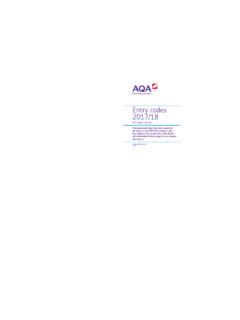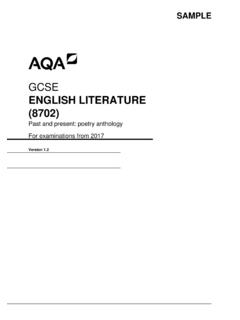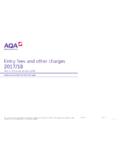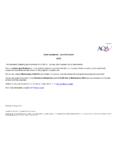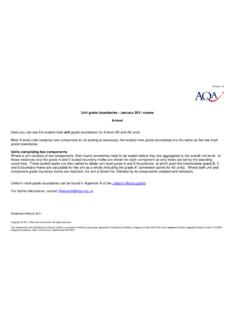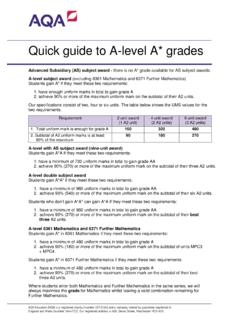Transcription of GCSE Mathematics For first teaching in 2015
1 GCSE Mathematics For first teaching in 2015 Copyright AQA and its licensors. All rights reserved. Summer 2014 Follow us on Twitter Structure of the session Overview of the new specification Summary of content and assessment objectives Underlying principles and key features AQA specification at a glance Break Specimen question papers Examples from the Foundation and Higher tier specimen question papers Support and resources Copyright AQA and its licensors. All rights reserved. Follow us on Twitter Objectives To understand the structure and key elements of the specification , teaching content and assessment To start thinking about the implications for teaching and learning To review the resources and support available from AQA To enable you to ask any questions about the specification Copyright AQA and its licensors.
2 All rights reserved. Follow us on Twitter Context Developed by an experienced team of teachers and examiners Designed to engage young people in this subject and provide effective assessments across the ability range Submitted to Ofqual for accreditation. Approval expected by September 2014 The new specification is for first assessment in summer 2017 Copyright AQA and its licensors. All rights reserved. Requirements for all GCSEs in Mathematics Written papers only Linear assessment all exams must be taken in the same series Summer exams for all November opportunity for students who were 16 on 31 August in that year Minimum assessment time of 412 hours 3313 - 50% non-calculator assessment Foundation and Higher tiers New grading structure 1-9, with 9 being the highest Foundation tier 1 5 Higher tier 4 9 Will carry a double weighting in the new accountability measures Copyright AQA and its licensors.
3 All rights reserved. AQA specification at a glance Copyright AQA and its licensors. All rights reserved. Students will be required to answer all questions on all papers The assessment structure will be the same for both foundation and higher tiers Paper 1: non-calculator Paper 2: calculator Paper 3: calculator Content Content from any part of the specification may be assessed Content Content from any part of the specification may be assessed Content Content from any part of the specification may be assessed Assessment 1 hour 30 minutes written exam 80 marks 3313 of GCSE Assessment 1 hour 30 minutes written exam 80 marks 3313 of GCSE Assessment 1 hour 30 minutes written exam 80 marks 3313 of GCSE New accountability measures From summer 2016 there will be four key measures: Students' progress across 8 subjects between KS2 and KS4 compared to their expected progress (Progress 8) School's average grade across the same suite of 8 subjects (Attainment 8) % of students achieving a C grade or higher in English and Maths % of students gaining the Ebacc Copyright AQA and its licensors.
4 All rights reserved. New accountability measures: Attainment 8 Grades will be converted into points Measured across a suite of eight subjects: Only first entry in each subject counts Copyright AQA and its licensors. All rights reserved. Core (x2) 20% each English Language or English Literature Maths EBacc (x3) 10% each Sciences Computer Science Geography History Languages Other (x3) 10% each English Literature or English Language Other EBacc subjects Approved non-EBacc subjects New accountability measures: Progress 8 Progress 8 = actual Attainment 8 minus expected Attainment 8 Presented as average number of grades above/below expectation A positive Progress 8 score shows more progress than expected School average Progress 8 is then calculated This is the only measure to have a floor target Copyright AQA and its licensors.
5 All rights reserved. Underlying principles of Mathematics at AQA Mathematics is for everyone Develop qualifications and support to enable students to engage, enjoy and succeed in maths Our qualifications equip students with the appropriate skills, whatever their chosen pathway Our question papers are accessible, allowing students to demonstrate their knowledge and understanding to achieve the results they deserve Work with teachers to develop resources and support materials that are of genuine help in the classroom Copyright AQA and its licensors. All rights reserved. Overview of specification content 1 The DfE has split the subject content into three groups: content that all students should master content that should be taught, but higher achieving students should master content that will be taught only to higher achieving students and mastered by the highest achievers (those likely to go on to A-level study in maths) Copyright AQA and its licensors.
6 All rights reserved. Overview of specification content 2 Copyright AQA and its licensors. All rights reserved. Subject area Foundation Tier weighting Higher Tier weighting Number 25% (35%) 15% (17%) Algebra 20% (17%) nMa : Ma 30% (35%) nMa : Ma No stipulation Ratio, proportion and rates of change 25% (subsumed in other areas) 20% (subsumed in other areas) Geometry and measures 15% (28%) 20% (28%) Probability and statistics 15% (20%) 15% (20%) The mathematical content is defined by the DfE s GCSE subject content and assessment objectives document. Figures in brackets show weightings for the current qualification Key changes from the existing specifications New content Additional content in the foundation tier New assessment objectives Copyright AQA and its licensors.
7 All rights reserved. Assessment Objective 1 Copyright AQA and its licensors. All rights reserved. Use and apply standard techniques Students should be able to: accurately recall facts, terminology and definitions use and interpret notation correctly accurately carry out routine procedures or set tasks requiring multi-step solutions Weighting: F 50% H 40% Assessment Objective 2 Copyright AQA and its licensors. All rights reserved. Reason, interpret and communicate mathematically Students should be able to: make deductions and inferences and draw conclusions from mathematical information construct chains of reasoning to achieve a given result interpret and communicate information accurately present arguments and proofs assess the validity of an argument and critically evaluate a given way of processing information Weighting: F 25% H 30% Assessment Objective 3 Copyright AQA and its licensors.
8 All rights reserved. Solve problems within Mathematics in other contexts Students should be able to: translate problems in mathematical or non-mathematical contexts into a process or a series of mathematical processes make and use connections between different parts of Mathematics interpret results in the context of the given problem evaluate methods used and results obtained evaluate solutions to identify how they may have been affected by assumptions made Weighting: F 25% H 30% Copyright AQA and its licensors. All rights reserved. General questions Foundation Tier Copyright AQA and its licensors. All rights reserved. Structure of Foundation Tier Papers Each paper will start with 4 multiple choice questions 4 further multiple choice questions are spread throughout each paper Early questions test the basic foundation content in a straightforward way As the paper progresses the basic foundation content is tested in more complex ways Towards the end of the paper additional foundation content is included, but is tested in a straightforward way Copyright AQA and its licensors.
9 All rights reserved. C D E F G 2 5 4 3 1 50% 50% Current GCSE linear 175 marks New GCSE 240 marks 53 marks 120 marks 50% 50% Focus on key grades Mastery of the basics Intrinsic structural demands Foundation tier structure Example of testing results Paper 1F Question 27b Part (b) 26% scored 4 16% scored 3 13% scored 2 17% scored 1 28% scored 0 Great discrimination and good source of marks on AO2 at the end of Foundation paper Example of testing results Paper 2F Question 24 Brand new topic from DfE content. 53% scored 3 marks 19% scored 2 marks 16% scored 1 marks 12% scored 0 marks Our team know how to assess new and demanding content in an accessible way Copyright AQA and its licensors.
10 All rights reserved. Questions on Foundation Tier Copyright AQA and its licensors. All rights reserved. Higher Tier Structure of Higher Tier Papers Each paper will start with 4 multiple choice questions 4 further multiple choice questions are spread throughout each paper Early questions test the additional foundation content in a straightforward way and the basic foundation content in a more complex way As the paper progresses the higher content is tested in a straightforward way and the additional foundation content is tested in a more complex way At the end of the paper higher content is tested in both straightforward and more complex ways Copyright AQA and its licensors. All rights reserved. A* A B C D 6 9 8 7 4 5 50% 50% Current GCSE linear 175 marks New GCSE 240 marks 53 marks 120 marks 50% 50% Sustained challenge at the top end Mastery of the basics Intrinsic structural demands Higher tier structure Example of testing results Paper 1H Question 21 Problem solving questions don t need to be in context or word-heavy Still a challenge!

